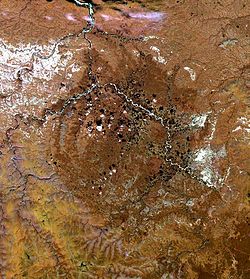Russia Reveals Trillions of Carats in Industrial Diamond Reserves (Updated)
September 18, 12
The official Russian news agency ITAR-Tass said A spokesperson from Russian mining giant ALROSA told IDEX Online, "This mineral, impactite, cannot be used in jewelry, so the Popigai deposit cannot change the structure of gem diamond market or impact diamond prices. Otherwise, this mineral probably can be used for industrial purposes. In any case, this object needs further exploration, as well as research on impactite’s features.” The report quoted scientists as saying the deposit was “enough to supply the world’s diamond needs for 3,000 years.” The deposit consists of impact diamonds – the kind that are created when a high velocity object like a meteor slams into a graphite deposit. Impact diamonds are distinct from ‘space diamonds’ which are diamonds that had already been embedded in extraterrestrial objects like meteors when they crashed into the earth. ITAR-Tass quoted Nikolai Pokhilenko, Director of the The resources of super-hard diamonds contained in rocks of the Popigai crypto-explosion structure, are by a factor of ten bigger than the world's all known reserves. We are speaking about trillions of carats, for comparison – present-day known reserves in Yakutia are estimated at one billion carats," he said. Pokhilenko went on to say, "The value of the impact diamonds is added by their unusual abrasive features and large grain size. This expands significantly the scope of their industrial use and makes them more valuable for industrial purposes – in metalworking, in the production of efficient semiconductors, etc." The reported indicated that the Popigai site is unique and would thus lead to The Popigai crater has fascinated paleontologists and geologists for a long time but remained an enigma as Russian authorities allowed no access to it. It was only after an expedition was allowed in 1997 that scientists got a clearer understanding of the structure. The meteor that struck the earth there is estimated to have been either a chondrite asteroid that was 8 km wide or a stony asteroid with a 5 km diameter. The shock of the impact instantly transformed graphite in the ground into diamonds within a radius of 13.6 km of the impact point. Most of these diamonds are between 0.5- and 2 mm in diameter, though a few exceptional specimens are 10 mm. The diamonds inherit the tabular shape and striations of the original graphite grains.

Aerial view of the Popigai crater